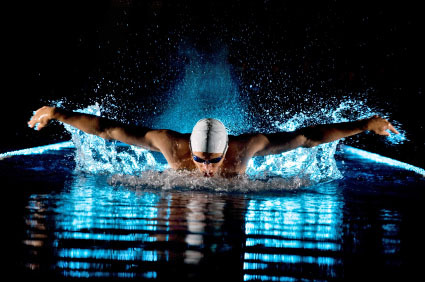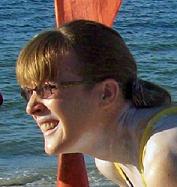Comparing The Butterfly Swim Stroke To The Freestyle Stroke
The butterfly swim stroke is a short axis swim stroke that is similar in arm muscle movement to the long-axis freestyle, (or front crawl swim stroke), but the arms move in unison, instead in reciprocal or alternating sequence. Essentially, they are almost identical in the muscle groups used, so you still use all major muscle groups, to optimize forward propulsion through the water.
One difference between the propulsive and recovery stroke of the freestyle and the pull, push and recovery of the butter-fly, is the way that energy is exerted to move you through the water. While the butterfly is probably one of the most fun strokes to master, it is also the most exhaustive. Strong shoulders are required, but they are developed, as you master this short axis swim stroke.
Butterfly Muscles
Swimmers that utilize the butter-fly swim stroke will still use the pectoralis major and latissimus dorsi, for major forward movement. In addition, the wrist flexors and the biceps are an essential part of this short axis swim stroke. There is a slight difference in the elbow, since it catches at a 40 degree angle of flexion in the butter-fly, versus the 30 degree angle in the freestyle stroke. Since the forceful extension of the elbow occurs during the final portion of pulling your body through the water, the triceps brachii perform a major function.
The Roll of a See-Saw
When comparing the butter-fly swim stroke to the freestyle, the obviously difference would be there isn’t a roll of the core, during the recovery phase of the butter-fly, like there is with the freestyle or crawl swim stroke. It still utilizes shoulder blade stabilizing muscles for anchoring and repositioning the arms, during the propulsive phase, but the core stabilizers are utilized and the arching of the back is due to the contraction of the multiple back muscles, including contraction of the paraspinal muscles - making it a short-axis stroke where you roll like a see-saw at the belly button.
Contraction of the abdominal muscles prepares the upper body for the next propulsive phase of this short-axis stroke, as the upper body follows the hands, into the water. While the kicking motion of the butter-fly uses the same muscles as the freestyle or front crawl swim stroke, the legs move in unison. The iliopsoas, rectus femoris and quadriceps muscle group facilitate the knee extension, while the gluteal muscles and hamstrings muscles extend the hip, with contraction. The butterfly kick maintains the plantar-flexed foot, which fights the resistance of the water. While the dolphin kick uses core stabilizers and the torso, it is mainly used to start races and kick off the turn wall.
Stroke Speed
When you are comparing the competitive swim strokes, freestyle is faster than the butterfly stroke. The butter-fly stroke is harder to master and even, some of the most expert swimmers can prove the point it isn’t considered the quickest stroke, when compared to the freestyle. When you compare the Olympics Men’s freestyle record for 100 meters at 47.84 seconds and the 100 meter, 51.25 second butter-fly of Michael Phelps, it’s easier to see the comparison.
Besides the extra effort and airtime associated with the butter-fly, mastering the synchronization of the push, pull and recovery phases can be more difficult to perfect. While the peak speed of the butter-fly stroke is faster than the freestyle, time is lost during the recovery phase. The other competitive swim strokes can be easier to master and they can still be swum by average swimmers. The same can’t be said of the butterfly, which requires proper technique, in addition to a strong upper body. To gain speed, synchronizing the over-water recovery phase is essential, so plenty of practice and proper technique is required, even by the most natural swimmers.
Today's Daily Swim Workout:
Warm-up: 600 as 25 butterfly kick or swim, 75 freestyle, continuous.
8 X 75 as 25 fly, 50 freestyle on cruise interval pace plus 5 second
Kick with short swim fins: 6 X 50 alternating breaststroke and butterfly by 50, 4 X 100 alternating backstroke and freestyle by 100
8 X 75 as 25 butterfly, 25 butterfly kick-on-back, 25 butterfly
Pull with hand paddles: 4 X 150 as 50 breaststroke, 100 freestyle
4 X 50 as 25 butterfly, 25 freestyle
6 X 50 alternating butterfly and freestyle by 50
Warm-down: 200 superslow tai-chi style freestyle
Total: 3800 meters or yards depending on the length of the pool
back to the top of butterfly page from butterfly page to swimming strokes page

Don't just build a website, build a web business!
Beauty is just a click away! Visit me, your Independent Beauty Consultant.









